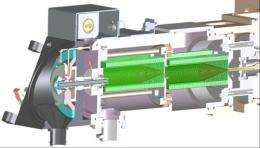Agilent’s new iFunnel ESI-MS interface consists of a multicapillary (6X600 um) inlet and dual ion funnels. An offset between the multicapillary inlet and the first high pressure ion funnel is used to reduce chemical background.
Ion funnel technology developed at Pacific Northwest National Laboratory that improves detection and measurement capabilities of mass spectrometry is again showing its commercial value. Agilent Technologies, Inc., has introduced its newest version of the Ion Funnel technology, the 6490 Triple Quadrupole LC/MS, as part of its iFunnel line.
Agilent kicked off marketing efforts for the new product at the American Society for Mass Spectrometry meeting last May, coinciding with execution of a license with Battelle—which operates PNNL—for the patents covering the technology.
Ion funnel technology was developed at PNNL in the 1990s by Dick Smith, director of proteomics research at PNNL; former PNNL scientist Harold Udseth; PNNL scientist Keqi Tang; and Scott Shaffer, now at the University of Washington. Called the electrodynamic ion funnel, the technology improves ion transmission in mass spectrometry a minimum of four to five times that of conventional technology.
The device is particularly effective when combined with an ion source capable of high efficiency ionization of a sample and for enabling use of multiple inlets to the mass spectrometer. The resulting increase in ion transmission to the mass spectrometer improves essentially all detection and measurement capabilities. The electrodynamic ion funnel received a 1999 R&D 100 Award and a 2004 Award for Excellence in Technology Transfer in association with a previous license of the technology to Bruker Daltonics, another major mass spectrometer manufacturer. The technology has also been licensed to ThermoFisher Corporation.
Provided by Pacific Northwest National Laboratory





















